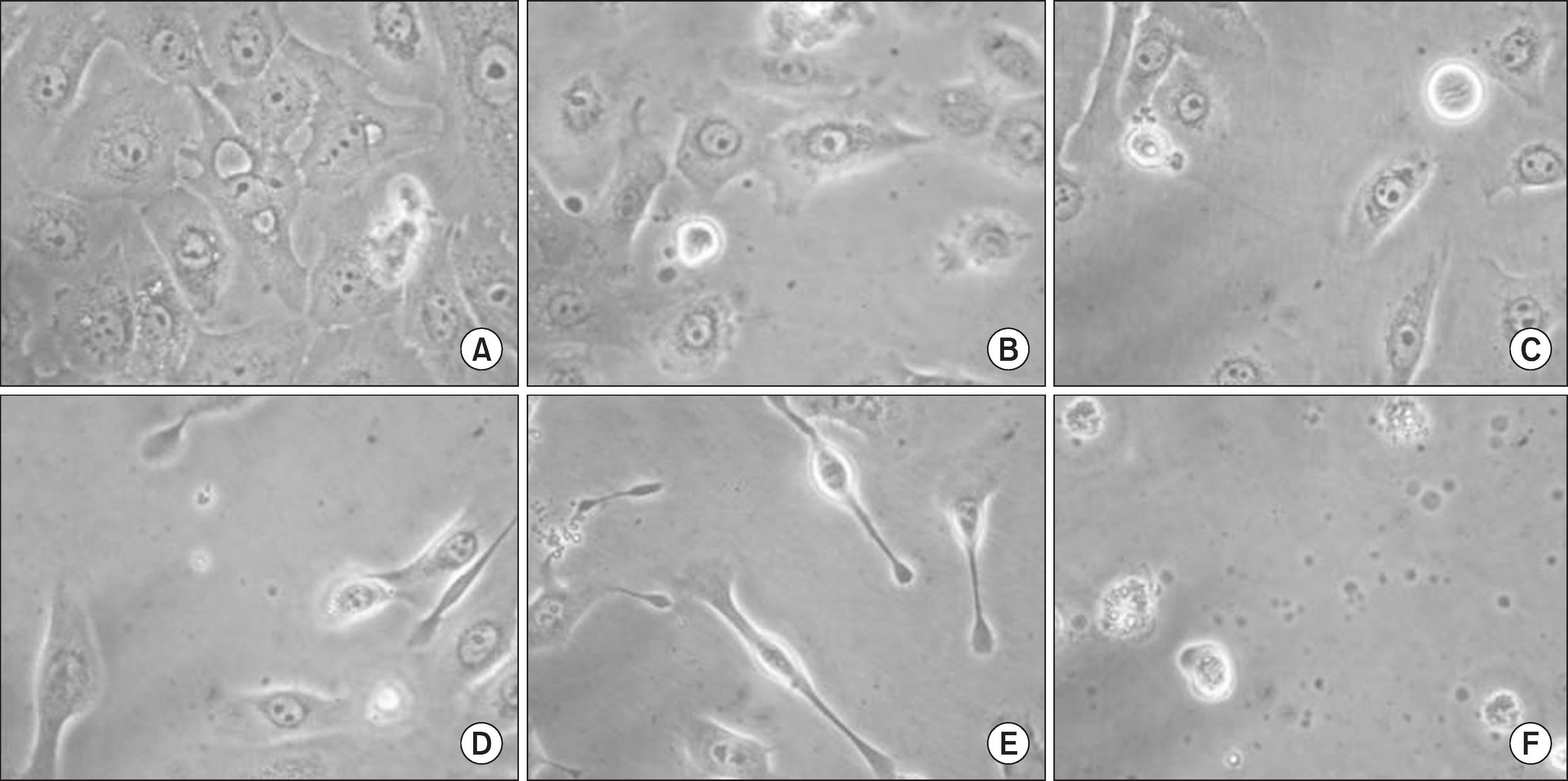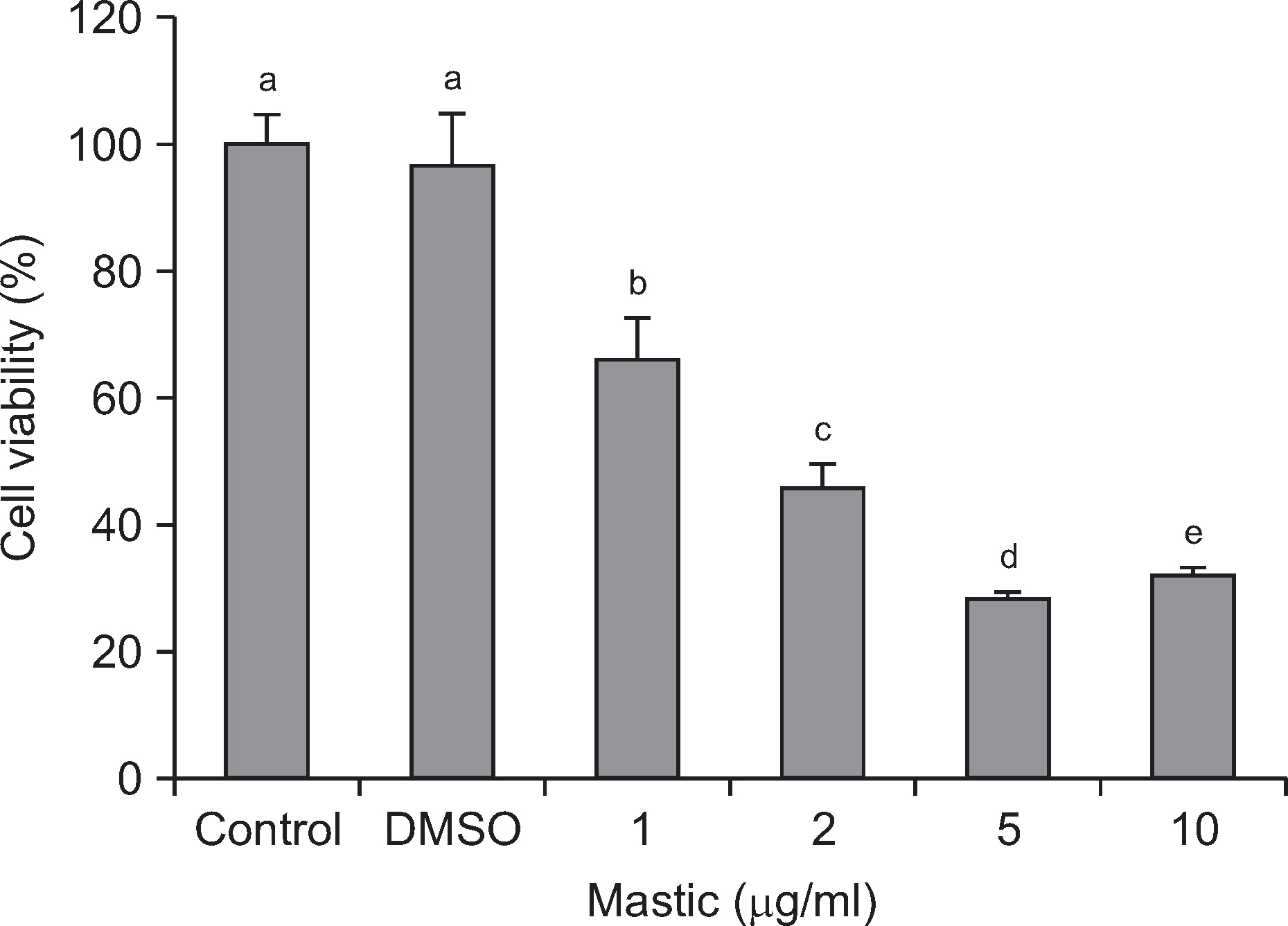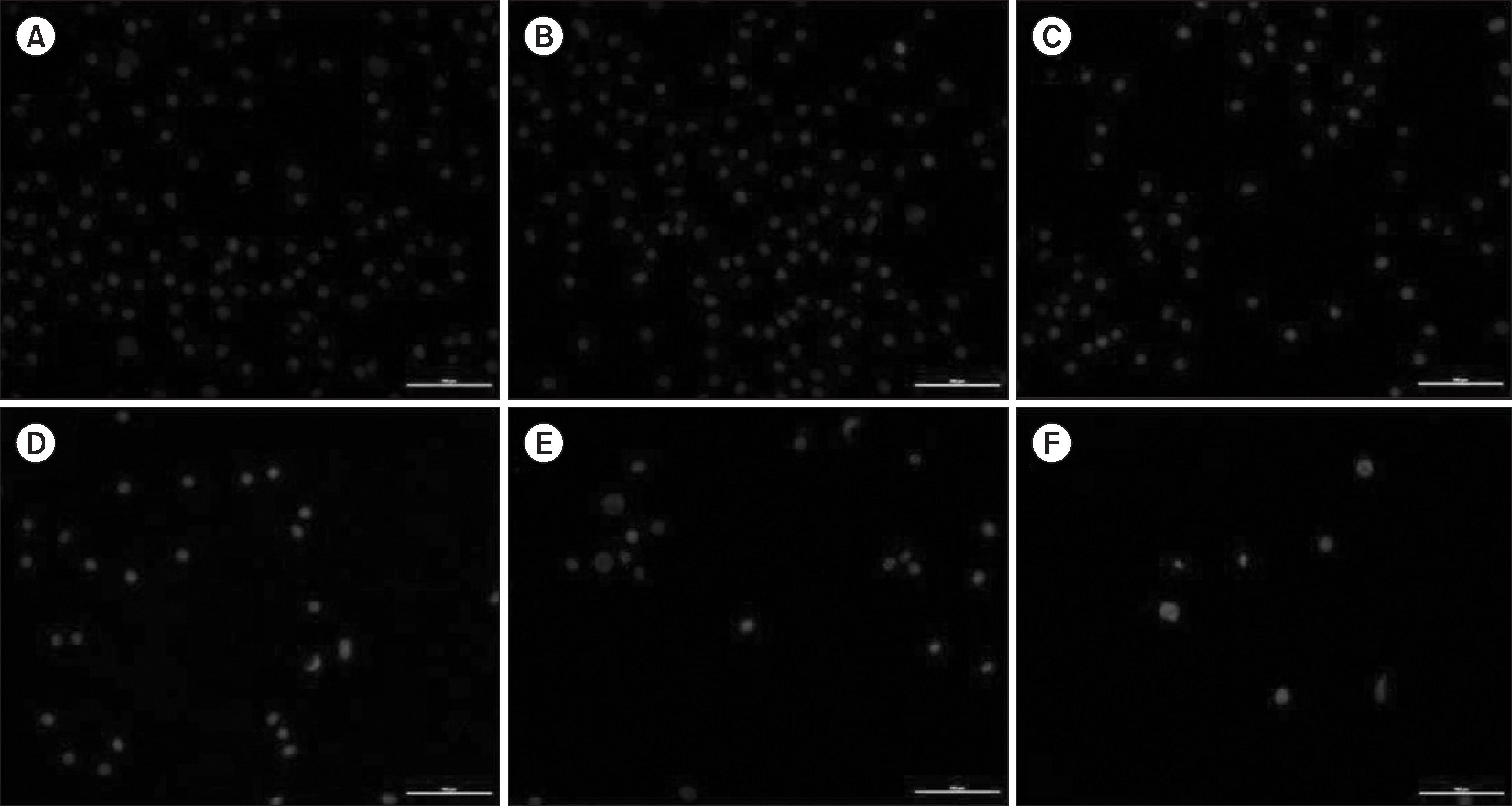J Korean Acad Oral Health.
2016 Sep;40(3):143-148. 10.11149/jkaoh.2016.40.3.143.
Anticancer effect of mastic on human oral cancer cells
- Affiliations
-
- 1Department of Preventive Dentistry, Kyungpook National University School of Dentistry, Daegu, Korea. kbsong@knu.ac.kr
- 2Department of Dental Hygiene, Daegu Health College, Daegu, Korea.
- KMID: 2354784
- DOI: http://doi.org/10.11149/jkaoh.2016.40.3.143
Abstract
OBJECTIVES
Mastic is a resinous extract from the stem and main leaves of Pistacia lentiscus, grown only in the Chios island of Greece. Mastic has antibacterial, anti-inflammatory, anticancer, and anti-ulcer activities. Although mastic has been widely studied, its inhibitory effect against cancer cells, especially oral cancer cells, has not been elucidated. The purpose of this study was to assess the anticancer effects of mastic on human oral cancer YD-10B cells.
METHODS
YD-10B cells were cultured in 0, 1, 2, 5, and 10 µg/mL mastic for 24 h. Cell count, viability, morphology, colony-forming assay, and DAPI staining were analyzed.
RESULTS
Mastic treatment of YD-10B cells resulted in a dose-dependent inhibition of cell growth, and almost all the cells in the 10 µg/mL culture were dead (P<0.05). Mastic treatment induced a morphological change and nuclear fragmentation in the YD-10B cells, and inhibited colony formation of YD-10B cells in a dose-dependent manner.
CONCLUSIONS
These results indicate that mastic exhibited anticancer effects on the YD-10B cells through changes in cell morphology and apoptosis.
Keyword
Figure
Cited by 1 articles
-
Inhibitory effect of mastic oil on
Streptococcus mutans growth
Doh-Hyun Lee, Ji-Hye Kim, Sagn-Uk Im, Yun-Sook Jung, Youn-Hee Choi, Keun-Bae Song
J Korean Acad Oral Health. 2020;44(4):175-179. doi: 10.11149/jkaoh.2020.44.4.175.
Reference
-
References
1. Silverman S JR. Demographics and occurrence of oral and pharyngeal cancers: The outcome, the trends, the challenge. J Am Dent Assoc. 2001; 132:7s–11s.2. Subramanian S, Sankaranarayanan R, Bapat B, Somanathan T, Thomas G, Mathew B, et al. Cost effectiveness of oral cancer screening: Results from a cluster randomized controlled trial in India. Bull World Health Organ. 2009; 87(3):200–206.3. O’Brien CJ, Smith JW, Soong SJ, Urist MM, Maddox WA. Neck dissection with and without radiotherapy: Prognostic factors, patterns of recurrence and survival. Am J Surg. 1986; 152(4):456–463.4. Lam L, Logan RM, Luke C, Rees GL. Retrospective study of survival and treatment pattern in a cohort of patients with oral and oropharyngeal tongue cancers from 1987-2004. Oral Oncol. 2007; 43(2):150–158.5. Chandu A, Sun KC, DeSilva RN, Smith AC. The assessment of quality of life in patients who have undergone surgery for oral cancer: A preliminary report. J Oral Maxillofac Surg. 2005; 63(11):1606–1612.
Article6. Canto MT, Devesa SS. Oral cavity and pharynx cancer incidence rates in the United States, 1975-1998. Oral Oncol. 2008; 38(6):610–617.7. Papageorge MB. Etiology of oral cancer in the young patient: Is tongue cancer becoming the other cancer in women? Oral Maxil-lofac Surg Clin North Am. 2007; 19(2):163–171.
Article8. Park JJ. Induction of apoptosis by berberine in KB human oral cancer cells [master’s thesis]. Gwangju: Chosun University;2013. [Korean].9. Lee HI. Chinensis Galla extract induces apoptotic cell death via caspase activation in YD-10B cell [master’s thesis]. Daegu: Daegu Hanny University;2009. [Korean].10. Kim SY. Anticancer effects of quercetin and rutin on KB human [dissertation]. Gwangju: Chosun University;2011. [Korean].11. Lee DS. Effects of Cnidium officinale MAKINO extracts on the KB human oral cancer cells [master’s thesis]. Gwangju: Chosun Univer-sity;2011. [Korean].12. Huwez FU, Thirlwell D, Cockayne A, Ala’Aldeen DA. Mastic gum kills Helicobacter pylori. N Engl J Med. 1998; 339(26):1946.13. Derwucg E, Manar A, Bebzaube Z, Boukir A. GC/MS analysis and in vitro antibacterial activity of the essential oil isolated from leaf of Pistacia lentiscus growing in Morocco. World appl Sci J. 2010; 8(10):1267–1276.14. Paraschos S, Mitakou S, Skaltsounis AL. Chios gum mastic: A review of its biological activities. Curr Med Chem. 2012; 19(14):2292–2302.15. Triantafyllou A, Bikineyeva A, Dikalova A, Nazarewicz R, Lerakis S, Dikalov S. Anti-inflammatory activity of chios mastic gum is associated with inhibition of TNF-alpha induced oxidative stress. Nutr J. 2011; 10(1):64.
Article16. Baily LH. The standard cyclopedia of horticulture. New York: The Macmillan Company;1935. p. 2638–2649.17. Magiatis P, Melliou E, Skaltsounis AL, Chinou IB, Mitaku S. Chemical composition and antimicrobial activity of the essential oils of Pistacia lentiscus var. chia. Planta Med. 1999; 65(8):749–752.18. Iauk L, Ragusa S, Rapisarda A, Franco S, Nicolosi VM. In vitro antimicrobial activity of Pistacia lentiscus L. extracts: Preliminary report. J Chemother. 1996; 8(3):207–209.19. Aksoy A, Duran N, Koksal F. In vitro and in vivo antimicrobial effects of mastic chewing gum against Streptococcus mutans and mutans streptococci. Arch Oral Biol. 2006; 51(6):476–481.
Article20. Biria M, Eslami G, Taghipour E, Akbarzadeh Baghban A. Effects of three mastic gums on the number of mutans streptococci, lactobacilli and pH of the saliva. J Dent (Tehran). 2014; 11(6):672–679.21. Balan KV, Prince J, Han Z, Dimas K, Cladaras M, Wyche JH, et al. Antiproliferative activity and induction of apoptosis in human colon cancer cells treated in vitro with constituents of a product derived from Pistacia lentiscus L. var. chia. Phytomedicine. 2007; 14(4):263–272.
Article22. He ML, Li A, Xu CS, Wang SL, Zhang MJ, Gu H, et al. Mechanisms of antiprostate cancer by gum mastic: NF-kappaB signal as target. Acta Pharmacol Sin. 2007; 28(3):446–452.23. Li S, Cha IH, Nam W. Chios mastic gum extracts as a potent antitumor agent that inhibits growth and induces apoptosis of oral cancer cells. Asian Pac J Cancer Prev. 2011; 12(7):1877–1880.24. Sun T, Tanumihardjo SA. An integrated approach to evaluate food antioxidant capacity. J Food Sci. 2007; 72(9):159–165.
Article25. Mahmoudi M, Ebrahimzadeh MA, Nabavi SF, Hafezi S, Nabavi SM, Eslami Sh. Anti-inflammatory and antioxidant activities of gum mastic. Eur Rev Med Pharmacol Sci. 2010; 14(9):765–769.26. Kaufmann SH, Earnshaw WC. Induction of apoptosis by cancer chemotherapy. Exp Cell Res. 2000; 256(1):42–49.
Article27. Giaginis C, Theocharis S. Current evidence on the anticancer potential of chios mastic gum. Nutr Cancer. 2011; 63(8):1174–1184.
Article
- Full Text Links
- Actions
-
Cited
- CITED
-
- Close
- Share
- Similar articles
-
- Inhibitory effect of mastic oil on Streptococcus mutans growth
- Methanol extracts of Asarum sieboldii Miq. induces apoptosis via the caspase pathway in human FaDu hypopharynx squamous carcinoma cells
- Studies on anticancer effects of extracts caesalpinia sappan on oral carcinoma and osteosarcoma cells
- Antibacterial Effects of Tea Tree Oil and Mastic Oil to Streptococcus mutans
- Anticancer effects of caesalpinia sappan extracts on oral carcinoma and osteosarcoma cells





